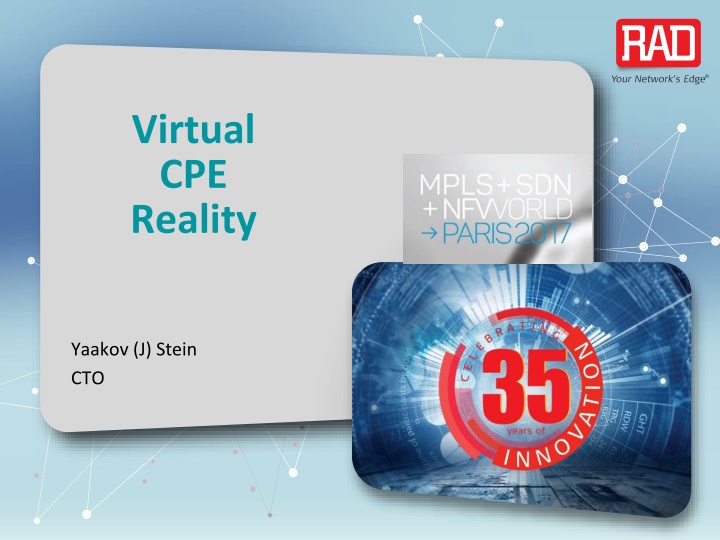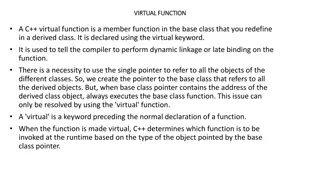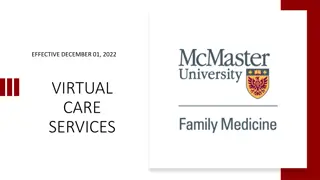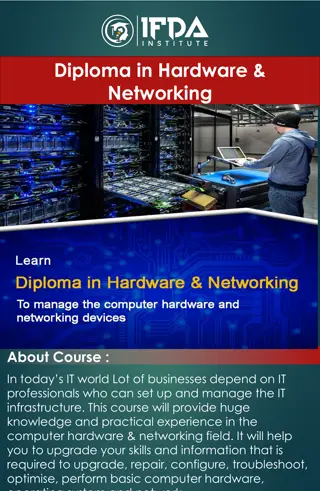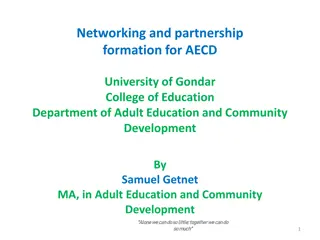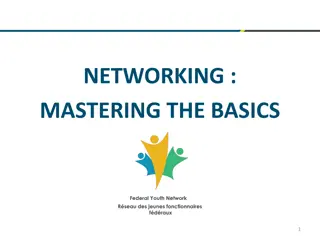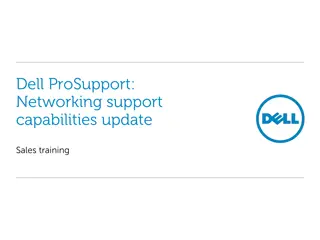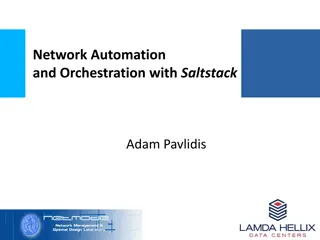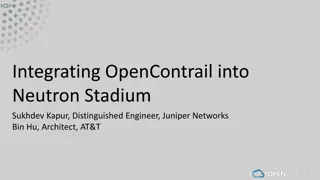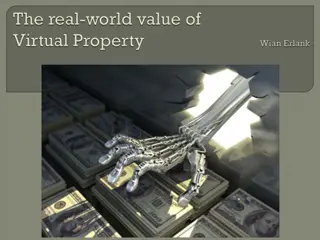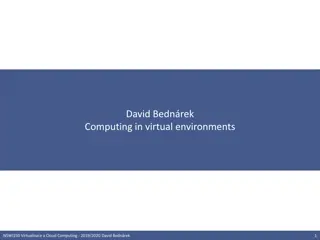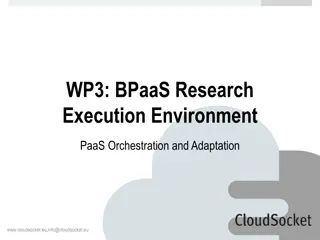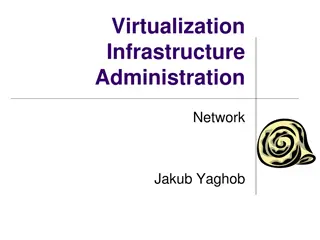Orchestration in Virtual Networking
Physical entities in networking are complex and expensive to develop. Virtual entities offer a more affordable and efficient alternative, enabling atomic functions and streamlined management. Orchestration, inherited from data center operations, plays a crucial role in SDN/NFV, automating resource management and workflows. This practice, akin to music orchestration, involves the deployment and monitoring of virtual resources in dynamic environments. Explore the evolution of orchestration and its significance in modern networking paradigms.
Uploaded on Feb 26, 2025 | 0 Views
Download Presentation

Please find below an Image/Link to download the presentation.
The content on the website is provided AS IS for your information and personal use only. It may not be sold, licensed, or shared on other websites without obtaining consent from the author.If you encounter any issues during the download, it is possible that the publisher has removed the file from their server.
You are allowed to download the files provided on this website for personal or commercial use, subject to the condition that they are used lawfully. All files are the property of their respective owners.
The content on the website is provided AS IS for your information and personal use only. It may not be sold, licensed, or shared on other websites without obtaining consent from the author.
E N D
Presentation Transcript
Virtual CPE Reality Yaakov (J) Stein CTO
Orchestration: Etymology Cynics opine that the only difference between conventional networking and SDN/NFV-enabled networking lies in replacing the word management with the word orchestration To investigate this claim we need to ask What is orchestration ? The term originates in music orchestration is the practice of writing/adapting music for an orchestra Note: the person who conducts an orchestra is a conductor not an orchestrator conducting is the art of directing a musical performance, i.e. setting the tempo ensuring ensemble members enter and exit at the appropriate times shaping phrasing according to policy To conform with the time-honored musical convention the composing of scripts by a DevOps writer should be orchestration the running of a management system really should be conducting Note: some web services chose yet another artistic analogy and talk of service choreography 2 Virtual (CPE) Reality
It all started with Data Center Orchestration ... So why do we use the term orchestration in SDN/NFV ? The term was inherited from data center operations In data centers orchestration denotes: the automated management and coordination of computational resources, workflows and services This task was originally carried out by sysadmins by writing scripts and so was aptly named orchestration With the advent of ubiquitous cloud services orchestration was redefined to: deploying and monitoring of virtualized resources and management of highly dynamic workflows But there is even more to the orchestration analogy ... 3 Virtual (CPE) Reality
Physical Entities Are Typically Complex Physical systems are expensive and time-consuming to develop and to deploy and are thus designed to be multifunctional For example, a physical router may really include the following functionalities: Ethernet switch IPv4 unicast forwarder IPv4 multicast forwarder IPv4 intradomain control protocol peer NAT firewall and many more ... DHCP server IPv6 unicast forwarder IPv6 multicast forwarder IPv4 interdomain control protocol peer tunneling endpoint IPsec gateway Hence for networks based on such physical entities management really means configuration : selecting desired functionalities from among the many available ones initializing each desired functionality Reacting to events in the network is mostly handled by control protocols 4 Virtual (CPE) Reality
Virtual Entities Can Afford To Be Atomic Virtual functions are inexpensive and fast to develop and deploy hence we can afford to make them atomic and build composite functions as needed by service chaining In a microservices architecture services have fine granularity interconnection protocols are lightweight services are independently deployable Atomic functions need to be dynamically placed at the proper place along the service path informed from whom to receive inputs and to whom to provide outputs informed as to (SLA related) policy considerations but require very little other configuration Hence for networks based on such virtual entities orchestration means functional selection, placement, and chaining but also real-timereaction to network events 5 Virtual (CPE) Reality
Orchestration: Revisited So, we now have a deeper understanding for the word orchestration A complex appliance is similar to an entire orchestra with its own conductor while an atomic virtual function is like a single musical instrument This is advantageous since the same violin can play many different scores, and play alongside 100 other instruments in a symphony orchestra play alongside 40 other instruments in a chamber orchestra play alongside 3 other instruments in a string quartet play alone in a solo performance An orchestra manager deals with financial aspects overall policy but doesn t get involved in the functioning of individual musicians An orchestrator has to intimately know each instrument and its relations to the others produce a score for each instrument give instructions to the conductor as to how to react in real-time 6 Virtual (CPE) Reality
Ramifications of Atomicity Functionality and APIs for atomic functions are simpler and may be better adapted to service requirements Functionality and APIs for atomic functions are more standardizable this leads to more drop-in options and less vendor lock-in, and expands the repertoire of service types using the same production process New atomic functions combinations can be created on-the-fly but only the compound function need be revealed to customers Atomic functions require fewer and less exotic resources and can hence be more easily located (even in weak vCPEs) and relocated There may be many more atomic functions to orchestrate but the amplification is by a factor, not by an order of magnitude Faults and root cause identification can be centrally handled based on standardized events from virtualized elements rather than mostly up to internal logic of complex physical element 7 Virtual (CPE) Reality
Operations for Conventional Networks In the operations of networks based on physical appliances configuration management is only one step out of many : long term planning (BSS) based on customer relationships and technological advances predict needed hardware resources from many link/equipment types purchasing, directing layout of physical resources service planning (OSS) based on customer requests and legal constraints (e.g., SLAs) determine how to most efficiently provide promised service management (NMS) configuration and commissioning testing control (protocols) monitoring and reporting reacting to events 8 Virtual (CPE) Reality
Operations for Orchestrated Networks There are fewer steps in operations for networks employing virtual entities long term planning (BSS) measure and collect trend information acquire three types of hardware resources 1. links (physical (fiber) or virtual (lambda)) 2. switches (physical (appliances) or virtual (vSwitches)) 3. computational (physical (CPU) or virtual (VM)) acquire pools of software licenses orchestration and control Note that short term planning has disappeared as it is carried out automagically by the orchestration system For example actual software images may be retrieved automatically It is interesting that SDN uses the term control in an attempt to emphasize its speed and dynamic nature On the other hand NFV uses the word management because it was more comfortable for service providers 9 Virtual (CPE) Reality
vCPE vs. Cloud-based NFV We already mentioned that NFV and orchestration facilitates function relocation In fact, NFV can not simply mean making appliances out of software - network appliances have been software-intensive for years! NFV actually means: 1. running network functionality on generic COTS whitebox servers 2. breaking down network functions into atomic functions 3. placement 4. chaining these functions together 5. optimizing and managing the computational and network infrastructures The first point is the definition of NFV, and we have discussed 2, 3, and 4 Cloud-based NFV satisfies 1-3 by replacing hardware with generic software but doesn t optimize the computational or network infrastructure The option to relocate VNFs to the (v)CPE fundamentally changes the network both in deploying functionalities in new places and potentially redirecting traffic in new ways (e.g., SD-WAN) 10 Virtual (CPE) Reality
Why vCPE ? (1) Why is the vCPE concept attractive to service providers? The originally envisioned advantage of NFV was performance scaling in order to maintain profitability margins vCPE platforms do not offer any CAPEX pricing advantage since typically CPE devices are already engineered for cost reduction In fact, generic software implementations are generally less efficient making it challenging even to meet appliance costs The advantage in vCPE is agility in function and service creation 11 Virtual (CPE) Reality
Why vCPE ? (2) This agility results in: reduced time to develop attractive new services e.g., SD-WAN services (a prime application of vCPE) reduced time to revenue and offering of Minimal Viable Products enhanced user experience try & buy quick turn-up, etc. user charged for functionality only when needed ability to support two VPN types in a single platform 1. IP (traffic can go through DC/HQ) 2. CE (ELINE) ability to support two fundamentally types of VNFs 1. customer visible Value Added Services (beyond basic connectivity) 2. operational (only visible to the service provider) from networking to IT premium services computications enabler (as discussed last year) 12 Virtual (CPE) Reality
From Management to Orchestration Customer Service load encrypt router firewall DPI balancing Cloud Management Orchestration router DPI firewall encrypt encrypt router wave internet encrypt cellular router MEC firewall encrypt firewall fiber CPE v DPI DPI storage encrypt router 13 Virtual (CPE) Reality
Yaakov (J) Stein CTO Yaakov_s@rad.com
